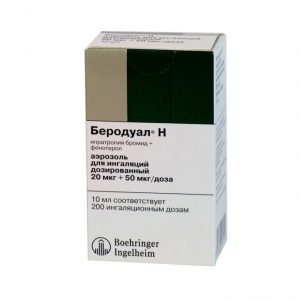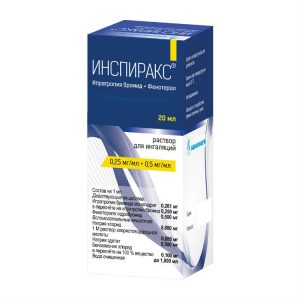Description
Release form
Powder for inhalation.
Packaging
Bottle 60 doses.
Pharmacological action of
Pharmacotherapeutic group:
bronchodilating agent – beta2-adrenergic agonist selective
ATX code: R03AC13
Pharmacological
pharmacodynamics that are responsive to 2 patients The therapeutic effect (bronchodilating effect) is achieved quickly, 1-3 minutes after taking the drug, and lasts an average of 12 hours after applying a single dose.
Pharmacokinetics
Absorption of
Formoterol is rapidly absorbed after inhalation. The maximum plasma concentration is observed 10 minutes after inhalation of the drug.
The average proportion of the drug that enters the lungs after inhalation using Turbuhaler is 28-49% of the delivered dose (corresponding to 21-37% of the inhaled dose). At higher lung concentrations, the total systemic bioavailability of the drug is 61% of the delivered dose (corresponding to 46% of the inhaled dose).
Distribution and metabolism of
Plasma protein binding is approximately 50%.
The drug is metabolized by direct addition of the glucuronic acid residue and O-demethylation. The enzyme involved in the O-demethylation reaction has not been established. Total plasma clearance and volume of distribution not established.
Excretion
The main part of formoterol is excreted as a result of metabolism. After inhalation, 8 13% of the delivered dose of formoterol (corresponding to 6 10% of the inhaled dose) is excreted unchanged in the urine. The half-life of the drug with inhalation is an average of 17 hours.
Indications
Oxis Turbuhaler is indicated in addition to corticosteroid therapy for regular maintenance treatment of bronchial asthma, for the relief of bronchospasm attacks, for the prevention of attacks caused by physical exertion.
In chronic obstructive pulmonary disease (COPD) for the prevention and treatment of broncho-obstructive symptoms.
Contraindications
Hypersensitivity to formoterol or lactose.
Children under 6 years.
Caution: prescribe the drug to patients with thyrotoxicosis, pheochromocytoma, diabetes, hypertrophic obstructive cardiomyopathy, idiopathic subvalvular aortic stenosis, severe hypertension, aneurysm, or other severe cardiovascular diseases, such as coronary artery disease, tachyarrhythmias, or severe heart failure.
Use during pregnancy and lactation
Clinical experience with the drug in pregnant women is limited. In experimental animals, rejection of the implant was noted, as well as a decrease in the life expectancy of the offspring in the early postnatal period and a decrease in body weight at birth.
These effects were observed with systemic exposures significantly higher than those achieved with clinical doses of the drug.
Bronchial asthma is a potentially dangerous disease, and therefore, its symptoms should be controlled during pregnancy. If it is necessary to ensure control of bronchial asthma, Oksis Turbuhaler can be used at all stages of pregnancy (see the section “Dosage and administration”).
However, as with any other drug, the decision to prescribe the drug during pregnancy can only be made when the expected effect for the mother outweighs any possible risk to the fetus.
It is not known whether formoterol passes into breast milk of women.
In experiments on laboratory animals (rats), the presence of small amounts of formoterol in breast milk has been shown.
The decision to appoint Oxis Turbuhaler to women during lactation is made in the case when the expected benefit to the mother exceeds any possible risk to the child.
Special instructions
Formoterol contained in the preparation enters the patient’s airways along with airflows when an active breath is taken through the mouthpiece of the Turbuhaler. It is important to clearly instruct the patient to take a deep and strong breath through the mouthpiece to ensure that the optimal dose of the drug enters the respiratory tract.
Also, the patient should be instructed never to chew or chew on the mouthpiece, do not use the Turbuhaler if the mouthpiece is damaged or the mouthpiece is disconnected from the Turbuhaler case.
The patient may not feel the taste or feel the drug after using Oksis Turbuhaler, due to the small amount of delivered substance.
It should be noted that patients with bronchial asthma who regularly take beta 2 -adrenomimetics, should receive optimal anti-inflammatory corticosteroid therapy. Patients should be advised to continue anti-inflammatory therapy even in those cases when improvement occurs after taking Oksis Turbuhaler. The persistence of symptoms or the need to increase the dose of beta 2 -adrenomimetics is a sign of a deterioration in the patient’s condition and requires a review of anti-asthma therapy.
Do not start treatment with Oksis Turbuhaler and increase its dose in case of exacerbation of the disease.
Do not exceed the maximum daily dose of the drug. There is no safety data for long-term continuous use of the drug at higher doses, such as 36 Ñg / day in adults and 18 Ñg / day in children with bronchial asthma, and 18 Ñg / day in patients with COPD.
Frequent use of the drug to prevent symptoms of bronchial asthma caused by physical exertion may indicate inadequate control of the course of the disease and cause a review of the treatment regimen used, as well as an assessment of the patient’s adherence to compliance with the applicable treatment regimen. If the need for the prevention of symptoms of bronchial asthma caused by physical exertion occurs several times within one week against the background of adequate supportive therapy (GCS, beta 2 -adrenergic agonists, long-term action), then it is necessary to review the current treatment regimen by a specialist.
In diabetes mellitus, the concentration of glucose in the blood should be monitored at the beginning of treatment, since beta 2 -adrenomimetics have a hyperglycemic effect.
As a result of beta 2 -adrenomimetics, severe hypokalemia can potentially develop. Particular care should be taken when exacerbating severe bronchial asthma, because the risk of hypokalemia may increase with hypoxia. Hypokalemia can be aggravated with concomitant therapy with xanthine derivatives, steroids, diuretics. In such cases, it is necessary to control the level of potassium in the blood serum.
As well as when using other inhalation therapy, it is necessary to consider the possibility of developing paradoxical bronchospasm.
The delivered dose of the drug contains 450 mcg of lactose (corresponding to 600 mcg in the measured dose). This amount, as a rule, does not cause problems in people with lactose intolerance.
Use for impaired liver function: No special dose selection is required for patients with impaired liver function when prescribing the recommended doses of the drug.
Use for impaired renal function: No special dose selection is required for patients with impaired renal function when prescribing recommended doses of the drug.
Use in pediatrics: Children under 6 years of age should not be prescribed the drug, since there is not enough information for this age group.
Influence on the ability to drive vehicles and control mechanisms: Oksis Turbuhaler does not affect the ability to concentrate and the speed of psychomotor reactions.
Composition
1 dose (1 inhalation) contains: Active ingredient:
formoterol fumarate dihydrate 4.5 ?g or 9 ?g
Excipient:
lactose monohydrate about 450 ?g
Dosage and administration
Inhalation
4.5 mcg / dose
Adults:
Normal dosage: 1 or 2 inhalations once or twice daily. The dose may be inhaled in the morning and / or evening. Some patients may need 4 inhalations once or twice a day. The maximum daily dose for regular maintenance therapy is 8 inhalations.
If necessary, additional inhalations in excess of those recommended for regular maintenance therapy can be taken by the patient to stop bronchospasm attacks up to a maximum daily dose of 12 inhalations (maintenance dosage plus doses taken as needed).
It is not recommended to take more than 6 doses (inhalations) of the drug for stopping one attack. The need to use the drug more than 2 times a day, and / or the use of dosages that exceed the recommended as normal maintenance therapy more often than 2 days a week, is a criterion for insufficient control of the disease, and the treatment regimen should be reviewed.
If there are nocturnal symptoms of bronchial asthma, the recommended dose can be taken once at night. Duration of action of the drugIt is about 12 hours.
When choosing a dosage, you must strive to prescribe the minimum effective dose.
Chronic obstructive pulmonary disease:
Normal dosage: 2 inhalations once or twice a day. The maximum daily dose for regular maintenance therapy is 4 inhalations.
If necessary, additional inhalations in excess of those recommended for regular maintenance therapy can be given by the patient to alleviate bronchial obstructive symptoms, up to a maximum total daily dose of 8 inhalations (maintenance dosage plus doses taken as needed).
It is not recommended to inhale more than 4 doses of the drug in one go. The need to use the drug more than 2 times a day, and / or the use of dosages, exceeding those recommended as normal maintenance therapy more often than 2 days a week is a criterion for inadequate disease control, and the treatment regimen should be reviewed.
Prevention of asthma attacks caused by exercise: 2 inhalations before exercise. Do not exceed the maximum daily dose.
Children 6 years of age and older:
Normal dosage: 2 inhalations once or twice a day. Do not take more than 4 inhalations per day.
Prevention of asthma attacks caused by exercise: 2 inhalations before exercise. Do not exceed the maximum daily dose.
Side effects
Frequently occurring (> 1/100)
Central nervous system: headache
Cardiovascular system: palpitations
Musculoskeletal system: tremor
Rarely (<1/100 Central nervous srdl , anxiety, sleep disturbance Musculoskeletal system: muscle cramps Cardiovascular system: tachycardia, changes in blood pressure Very rare (<1/1000) Skin: rash, urticaria, pruritus Cardiovascular system: atrial fibrillation, supraventricular tachycardia, extraschrhythmia, extras hyperkalemia Respiratory: bronchospasm Tremor and heart palpitations are temporary and disappear during treatment. As with any inhalation therapy, in very rare cases, the development of paradoxical bronchospasm is possible. Isolated cases of the following side effects are described: nausea, taste disturbance, dizziness, angina pectoris, prolongation of the QTc interval, hypersensitivity reactions, changes in blood pressure and hyperglycemia. The use of? 2 sympathomimetics can increase blood levels of insulin, free fatty acids, glycerol and ketone. Drug Interactions No specific studies have been conducted on the drug interaction of Oksis Turbuhaler with other drugs. With simultaneous use with other sympathomimetics (ephedrine) Oksis Turbuhalera, side effects of the latter may be enhanced. With simultaneous use with xanthine derivatives, corticosteroids, or diuretics (thiazide and loop diuretics), hypokalemia may be enhanced. Hypokalemia may increase the risk of arrhythmias in patients receiving cardiac glycosides. With the simultaneous use of Oksis Turbuhaler with drugs that extend the QTc interval (including antihistamines: terfenadine, astemizole, misolastine with antiarrhythmics: quinidine, disopyramide, procainamide erythromycin and tricyclic antidepressants), the risk of ventricular arrhythmias may increase. There is a risk of arrhythmias in patients receiving Oxis Turbuhaler and concomitant anesthesia with halogenated hydrocarbons. Beta-blockers can partially or completely block the effect of the drug (especially in cases where non-selective -adrenoreceptors are used). In this connection, Oxis Turbuhaler should not be prescribed together with beta-blockers (including eye drops), except for the urgent need for joint use. overdose There is no clinical experience with overdose. It is most likely that the symptoms typical of other 2-adrenomimetics will be observed with an overdose: tremor, headache, palpitations. In some cases, tachycardia, hyperglycemia, hypokalemia, QTc lengthening, arrhythmia, nausea, and vomiting have been reported. Symptomatic and supportive treatment is shown. It is possible to appoint cardioselective -blockers, but this should be done with great caution, since the appointment of blockers of -adrenergic receptors can provoke the development of bronchospasm. It is necessary to control the level of potassium in the serum. Storage Conditions The product should be stored at a temperature not exceeding 30 ° C. Shelf life 2 years. Deystvuyushtee substance Formoterol Terms and conditions prescription Dosage form powder for inhalation Possible product names Oksis 4.5mkg turbuhaler Por. d / ing. 60 doses (R) /! Until 01.13g / Oksis 4.5mkg turbuhaler Por. d / ing. 60 doses (R) /! Until 07.13g / Oksis 4.5mkg turbuhaler Por. d / ing. 60 doses (R) /! until 08.09g. / Oksis 4.5mkg turbuhaler Por. d / ing. 60 doses / until 07.08 y. / (R) Oksis 4.5mkg turbuhaler Por. d / ing. 60 doses / until 10.2007 / (R) AstraZeneca, Britain




